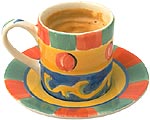Doodling Shake Bot DIY STEM Kit
$9.99$4.95
 It would seem that it should not matter whether you poured the cream into the
coffee or the coffee into the cream. The final temperature in either case should
be same.
It would seem that it should not matter whether you poured the cream into the
coffee or the coffee into the cream. The final temperature in either case should
be same.
 'There is no inductive method which could lead to the fundamental concepts of physics. Failure to understand this fact constituted the basic philosophical error of so many investigators of the nineteenth century.'
'There is no inductive method which could lead to the fundamental concepts of physics. Failure to understand this fact constituted the basic philosophical error of so many investigators of the nineteenth century.'